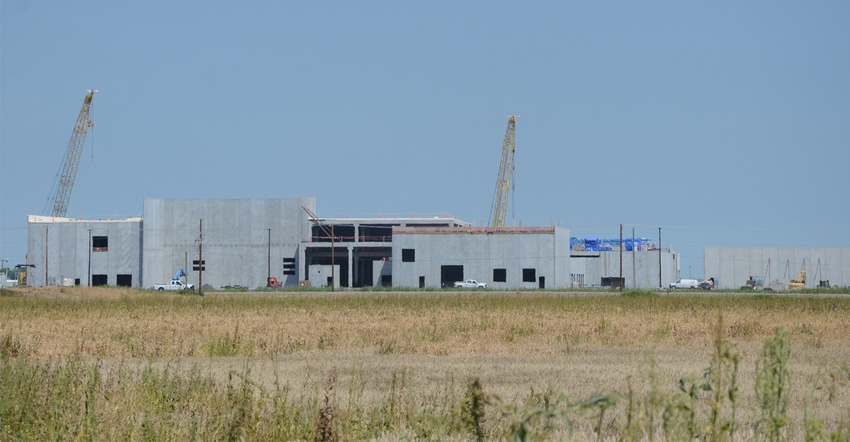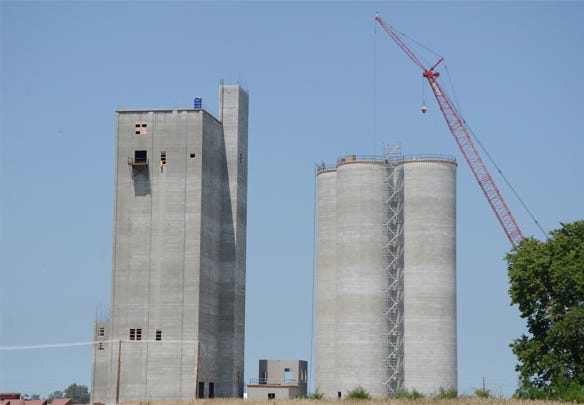
When you get down to it, it’s no small task to introduce a new agricultural production system to a region. It takes coordination, planning and plenty of labor. Take Lincoln Premium Poultry — the company that’s managing the production process for the new state-of-the-art Costco poultry processing facility in Fremont, Neb.
It takes a certain number of producers to raise 2 million birds weekly to supply the plant, and it takes a consistent market provided by the facility for those producers. Bringing those two things together simultaneously is a feat in and of itself.
The facility is projected to start operating in September 2019, and all 432 broiler barns needed to supply it will be completed by then. Ideally, the barns scheduled to provide the first shipment of broilers will be producing birds by 10 weeks before.

MEETING DEMAND: To meet the demand for the Freemont facility, it will take 13,500 tons of feed to for the 2 million birds processed weekly. That includes 350,000 bushels of corn and 3,000 to 4,000 tons of soybean meal per week. “That represents 80% to 85% of the diet,” says Walt Shafer, project manager at Lincoln Premium Poultry. “It’s all based on local resources; there is no rail going into the mill.”

For every building, all the dirt work and construction will be finished, and within 30 days before the first flock of birds comes in, the electrical wiring will be installed.
“From the time you express an interest in building to the time you’re up and running, it’s about six months,” says Walt Shafer, project manager at Lincoln Premium Poultry. This includes site approval, engineering and developing a nutrient management plant. “With that asset, they don’t want it sitting idle for very long. It takes a little over six weeks to grow a bird from chick to a bird that we need.”
Don’t be intimidated by tech
The biggest challenge is introducing a new production system to producers not familiar with poultry production, or the technology that goes with it. “The biggest challenge is really [that] no one knows poultry,” Shafer says. “Growers get intimidated by this technology, but we have service personnel that will work with them for as long as they’re raising birds with us.”
Those 600-by-63-foot barns are all automated and computer-controlled, Shafer says. He manages four barns of his own in Virginia. “You can look at an iPad or iPhone and make adjustments from here on my farm in Virginia,” he says.
The technology includes automated weigh cells that keep track of chicks’ weights as they walk across the barn and automated record keeping of feed inventories for every bin, as well as temperature sensors, water meters, automated vents, cool-cell technology and tunnel ventilation.
The cooling system includes vent inlets every 16 feet throughout the barn. Tunnel ventilation and cool-cell technology are used to keep the birds cool.
Cool-cell pads on each side of the barn feed the tunnel intake and cool the air as it goes through the inlets into the barn. During the heat peak days of the summer, that tunnel door opens to let in a massive amount of air.
“Then the sensor will tell the well to start saturating this cooling cell with water. Now the air is going through a water-saturated medium, like if I put water on your shirt and ran air over it,” Shafer says. “It’s almost worth a 30-degree temperature change on that bird.”
That automated technology extends to bird handling in the barn. Each broiler barn will have 42,000 birds at a time, with six flocks going through the barn annually.
“Six-and-a-half weeks after chicks come to the barn, I’ve got machines that drive through that barn that look like combines. We’re doing automated chick catching,” Shafer says. “It handles the birds better than catching them by hand. The technology will benefit both birds and handlers.”
The machine, an Apollo, is used to safely handle and collect the birds from the barn. Birds are then transported to the processing facility in covered trailers that have a top that raises up and down for ventilation and a curtain that keeps wind chill off them in winter. In summer, mesh is used instead.
Value of a new resource
Another part of the learning curve for Nebraska growers is using a new resource: poultry litter. Each broiler barn will produce about 1,200 tons of litter and will be cleaned out on an annual basis.
After each flock leaves, litter is windrowed in the barn, where it heats up to 140 to 150 degrees F, and breaks down solids and bacteria.
Windrows are turned several times and then spread back out to serve as insulation to chicks. The litter will be up to 6 inches deep across the floor of the barn, and the depth will be adjusted as manure is taken out. When a new group of birds comes in, wood shavings are spread back over the floor as a carbon base.
The value of that 1,200 tons of litter per year is about $40,000 per year — on top of the annual income the birds provide.
A typical 20-acre, four-barn broiler site takes an investment of $2.3 million to $2.4 million. Costco provides a 15-year loan to cover the cost, while Lincoln Premium Poultry owns the chicks and provides all inputs needed except labor. On top of the manure value leaving the barns, the birds from a single site typically bring $95,000 per year. Growers take part in a 15-year contract, and that contract guarantees a market and base pay for their birds, and rewards those that go above and beyond.
“I don’t know any 20-acre piece of land that will do that,” Shafer says. “This brings the next generation home, and it solidifies that family farm that’s been on the land four or five generations.”
“Costco’s demand is growing every day and every year. I would like to think if we’re successful here, they could replicate this process, maybe here in Nebraska for a second plant,” he adds. “I emphasize we have to have the first facility up and running to complete all we said we would do. Right now, we need growers. We could use another 50 to 60 growers for 2019.”
About the Author(s)
You May Also Like






